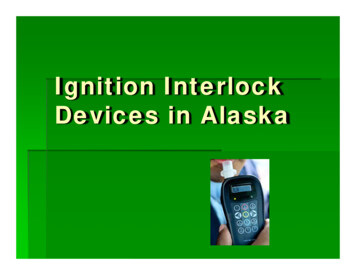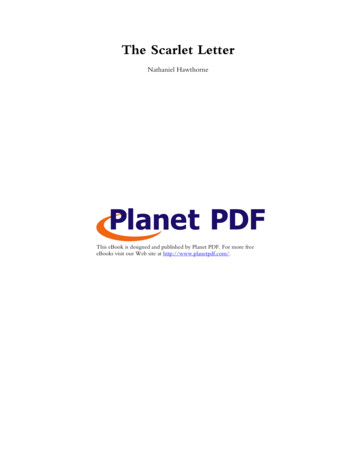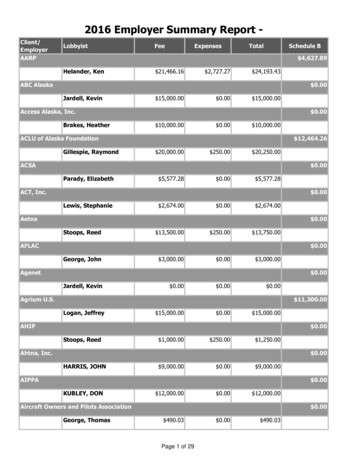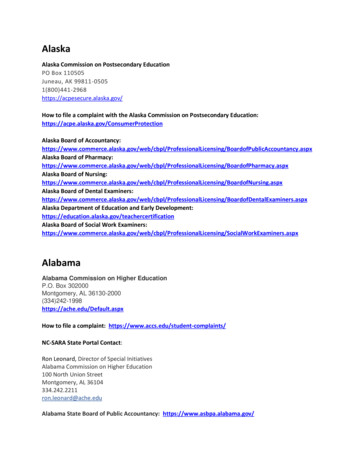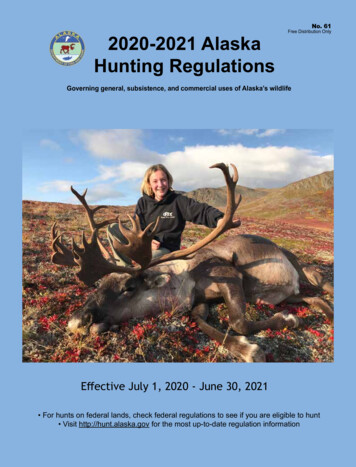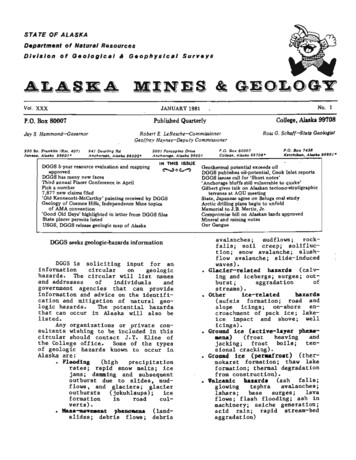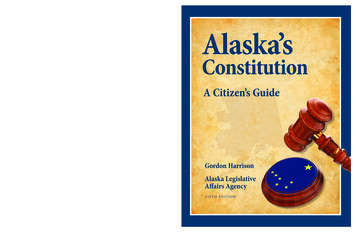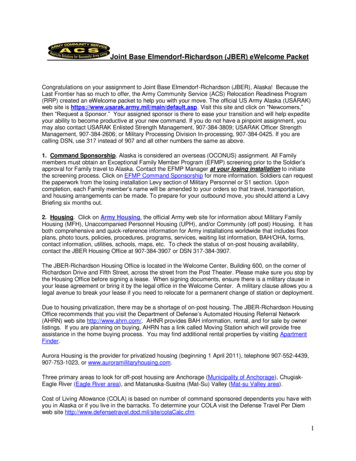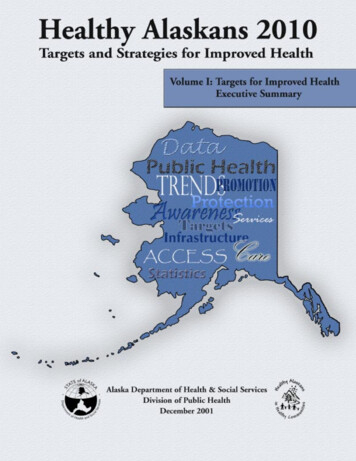
Transcription
AcknowledgmentsKaren Pearson, Director of the Division of Public Health, has championed the Healthy Alaskans 2010effort from the start, providing vision, encouragement and personal attention. Commissioner JayLivey, former Commissioner Karen Perdue, Administrative Services Director Janet Clarke, and formerDirector of Public Health Peter Nakamura have given constant support for a new “roadmap” to guidepublic health policies and programs for the first decade of the new century. Hundreds of individualsacross the state in and out of state government have admonished, advised, and assisted. The staffthank you all.Thanks to the staff of the Data and Evaluation Unit, past as well as current, who wrote, prepareddata, and edited: Debbie Lowenthal, Health Planner; Susan Keady, Research Analyst; Elvin Asay,Analyst Programmer; Dorothy Douglas, Health Program Manager; Margo Waring, MA, Health Planner; Mary Catherine Schumacher, MD, MSPH, Public Health Medical Specialist. Thanks to Deb Ericksonfor her contributions throughout the process, as staff member and then as Deputy Director of theDivision of Public Health. Karen Hall served as Administrative Assistant. Jim Craig, PublicationsSpecialist, accomplished photography and design work as well as preparation for publication. JulieSanbei, Publications Technician, assisted with graphics and artwork.We also wish to thank the staff in other Sections within the Division of Public Health who served aschapter leads, facilitated group discussions, and drafted text and tables for Healthy Alaskans 2010.Research staff, especially senior Research Analyst Phillip Mitchell, of the Bureau of Vital Statisticshave been close partners. Staff of other divisions and departments, and health care provider andadvocacy organizations provided information about programs, participated in meetings, and draftedsections. Greg Williams, State Demographer, provided essential population data.Healthy Alaskans Partnership Council members and alternates, and agency staff who have attendedmeetings of the Council and numerous chapter-planning meetings, deserve credit for their commitment and contribution to the process.Healthy Alaskans Partnership Council participants have included: Bill Allen, Donna Bacon, MikeConway, Kathy Craft, Bettye Davis, Traci Davis, Laraine Derr, Joan Domnick, Charlie Fautin, JoAnnHagen, Mark Hamilton, Auriella Hughes, Jewel Jones, James Jordan, Cheryl Kilgore, Cecile Lardon,Walter Majoros, Carmen Rosa D.C. Mallipudi, Christopher Mandregan, Bonnie McMahon, PeterNakamura, Cynthia Navarrette, Brenda Norton, Karen Pearson, Richard Rainery, Rhonda Richtsmeier,Susan Rinker, Lisa Sadleir-Hart, Brian Saylor, Paul Sherry, Deborah Vo, Peter Wallis, Pam Watts,Kathryn Davey, Delisa Culpepper, Kristin Ryan, Jean Becker, Dee Blake, Robert Ruffner, StanSteadman, Cindy Baldwin-Kitka, Laura Wertz-Stein, Nancy Merriman, Anne Henry, Diane MacMillan,Janet Clarke, Jay Livey, Tom Lefebvre, Bill Stokes, Kathryn Cohen, Susan Soule, and others.
Table of ContentsACKNOWLEDGMENTSINTRODUCTIONWhat is “Healthy Alaskans 2010?”.Background.Purpose and Use of this Plan (Volume I, Volume II).How to Use this Document.Healthy Alaskans 2010 as a Work in Progress.How to Use Healthy Alaskans 2010 Volume II:Strategies for Improved Health.88991111OVERVIEW OF ALASKA AND THE HEALTH STATUS OF THE POPULATIONThe State and Its Population.Births.Deaths – Leading Causes.Protective and Risk Factors.Leading Health Indicators.The Challenge to Eliminate Health Disparities.141819202226HIGHLIGHTS OF HEALTH TOPICS CHAPTERS OF HEALTHY ALASKANS 2010 VOLUME I:TARGETS FOR IMPROVED HEALTHHealth Promotion.Health Protection.Preventive Services and Access to Care.Public Health Infrastructure.32353843APPENDICESA. Healthy Alaskan Partnership Council Members and Alternates.B. Healthy Alaskans Chapter Leads.C. Abbreviations used in Healthy Alaskans 2010.D. Technical Notes.48495154
IntroductionIntroduction What is Healthy Alaskans 2010BackgroundPurpose and Use of this DocumentHow to Use this DocumentHealthy Alaskans 2010 as a Work in ProgressHow to Use Healthy Alaskans 2010 Volume II:Strategies for Improved HealthHealthy Alaskans 2010 - Executive Summary7
IntroductionWhat is Healthy Alaskans 2010?Healthy Alaskans 2010 is a framework for realizing avision: healthy Alaskans in healthy communities. It isa plan that includes a set of targets for 2010 that, ifachieved, would reflect improved health status since2000. A planning process involving participants fromacross the state has produced the following set of goals,selected indicators and targets for those indicators.These provide a framework for action at the local andstate level, and a way to address new problems withnew measures.This Executive Summary contains the introductorychapter and overview from Volume I of the full report,as well as highlights of the chapters addressing twentysix health topics in Volume I: Targets for ImprovedHealth of Alaskans.Volume II: Strategies for Improved Health will providemodels and strategies for realizing the targets identified in Volume I. The third step in the planning processwill be to outline action steps and policy recommendations for state government efforts to assist in achieving the targets.Healthy Alaskans 2010 emerged from the Alaska Public Health Improvement Process, funded in part by theRobert Wood Johnson Turning Point grants. It is a statefocused adaptation of the national planning processcalled Healthy People 2010, sponsored by the UnitedStates Department of Health and Human Services.The Alaska Department of Health and Social Serviceshas reached out to develop partnerships for the review of needs and development of targets for improving health status and access to care. The Departmentrequested that the Alaska Public Health ImprovementProcess Steering Committee guide the Healthy Alaskans 2010 planning process. With broader membership, the group is now established as the Healthy Alaskans Partnership Council. One of the Council’s coreprinciples is that broad community participation ensureslocal ownership. The community guides the process— collective thinking ultimately results in more sustainable solutions to complex problems and builds theexperience for responding to emerging needs. Collaboration and partnership with communities, Native healthorganizations, and health care workers are consideredessential to mobilizing the state for achieving goalsfor longer and healthier lives.Engaging people and their communities to improve8health status means that all members of the community – individuals and organizations — are public healthpartners. Local governments in Alaska are not mandated to assume responsibilities for public health butmay do so through local ordinance. At the present time(2001) only the North Slope Borough and the municipality of Anchorage have health powers and offer services similar to city and county governments elsewhere.Regional Native health corporations, community healthcenters, hospitals, emergency medical personnel, aswell as non-profit organizations and care providers alldo health promotion and prevention work in additionto providing treatment services. They are key partnersfor improving health of the population.BackgroundAlaska’s people and communities cope daily with challenges to maintain health and well-being. Informationabout trends in health status suggests that Alaskanshave been able to solve many of their health problems. For example, we have reduced injuries and illnesses related to weather, work settings, and geographical isolation of communities. But as a strongerhealth care and prevention system makes progresson old problems like tuberculosis, and as sanitationsystems improve access to safe water and waste disposal, new challenges appear. Increases in obesity,diabetes, heart disease, “baby bottle tooth decay,” andsuicides point to a need for changes in how we eat,exercise, and care for one another. Many communities across the state are engaged in local efforts toimprove their quality of life, the health of residents,and their economic base – they have demonstratedcommitment to “healthy Alaskans in healthy communities.”Nationally, “healthy people in healthy communities” hasbecome the theme of modern health planning, with anexpectation that state and federal government effortswill support local initiatives for improving health. Public health, defined by the World Health Organizationas “the science and organization of promoting health,preventing disease, and prolonging life through the organized efforts of society,” works with community members and their leadership, health care professionals andorganizations, employers, schools and universities, andothers.In the last decade, the Alaska Department of Healthand Social Services (DHSS) developed state healthobjectives for the year 2000 based on Healthy People2000: National Health Promotion and Disease Prevention Objectives. Healthy Alaskans 2000, published inHealthy Alaskans 2010 - Executive Summary
Introduction1994, presented a plan to assess the health status ofAlaskans and identify key actions to be taken to makeprogress on certain health indicators in Healthy People2000’s Priority Health Areas.1 In 1998 and in 2000,DHSS published reports on measurable progress toward the objectives, in the document “Health Status ofAlaskans.” (see ons.html)Entering the new century, a national process set newhealth objectives for the nation. Healthy People2010:The National Health Promotion and Disease Prevention Initiative provides an updated set of goals andnew measures of health status. The new national document emphasizes links between individual health andcommunity health. The physical and social environments in which people live, work, and play need to betaken into account. Beliefs, attitudes, and behaviorsof everyone who lives in the community affect othersand the community as a whole.The national Healthy People 2010, like its predecessor, was developed through a broad consultation process, built on the best scientific knowledge and designed to measure trends over time. The twooverarching goals of Healthy People 2010 are: To help individuals of all ages increase life expectancy and improve their quality of life.To eliminate health disparities among different segments of the population.Many states, including Alaska, have taken the opportunity to relate the national framework to their own issues. Healthy Alaskans 2010 Volume I: Targets forImproved Health will be used over the decade to trackchanges in health status of Alaskans. It serves as aframework for health policy development. It reflectsAlaskans’ priorities and objectives for improving healthstatus, modifying exposures to health risks, strengthening health care services, and reducing environmental and occupational hazards. The twenty-six problemspecific chapters have been completed by the staff ofDHSS, with assistance from other state agencies andfrom other health care organizations. The objectivesand targets for each chapter were presented at a fullday workshop following the Alaska Public HealthAssociation’s December 2000 Health Summit.The second volume, Healthy Alaskans 2010 VolumeII: Strategies for Improved Health, identifies those strategies for action to achieve the goals and objectivesfor health set in Volume I: Targets for Improved Health.The Department of Health and Social Services HealthyAlaskans 2010 Action Plan will include steps DHSSwill take to implement the strategic plan and reach thetargets set for this decade. The action plan in VolumeII will serve as a roadmap to a healthier Alaska, providing guidance for state action and services and forpartners in this endeavor.Purpose and Use of this PlanHealthy Alaskans 2010 Volume I will: Serve as a framework for health policy developmentIdentify best indicators of health statusProvide a basis for tracking changes in healthstatus of Alaskans over the next decadeSet ambitious but achievable targetsThe health status of a population can be tracked, analyzed, and improved through public health programsonce a baseline point of reference is identified. Thebaseline may be the death rate, disease incidence orprevalence rate among a certain group of people.Trends in individual behaviors like smoking and bingedrinking that can affect health in the short or long termcan be measured through population-based samplesurveys such as the Behavioral Risk Factor Surveillance Survey. Environmental conditions that are protective of good health or that pose threats to good healthcan also be tracked. The indicators recommended fortracking over the decade include all three types ofmeasures: health status, behaviors that can affecthealth and wellness, and environmental factors. Theindicators also include inventories of services,workforce, communications capabilities, and specificcapacities of the public health infrastructure and thehealth services delivery system.How to Use this DocumentFollowing the introduction, Healthy Alaskans 2010 Volume I is divided into four main sections: Health PromotionHealth ProtectionPreventive Services and Access to CarePublic Health InfrastructureWithin each of these broad cluster areas are chapters(or focus areas) on more specific topics related to setsof health conditions or risk or protective factorsHealthy Alaskans 2010 - Executive Summary9
Introduction(see Table 1). The groupings reflect important conceptual common themes, but many chapters could have beenincluded in another section as well. Cross references are provided in the appendices to Volume I. For example,the “tobacco use” chapter is included in the health promotion section, because of the current focus on developing awareness, discouraging early smoking, and encouraging smoking cessation, although some of the strategies for prevention include non-smoking ordinances for public places, tobacco taxes, and other options for stateor local regulations that fall into the category of “health protection.”Table 1. Healthy Alaskans 2010 Focus AreasHEALTH PROMOTION1. Physical Activity and Fitness2. Nutrition and Overweight3. Tobacco Use4. Substance Abuse5. Mental Health6. Educational and Community-based Programs7. Health CommunicationHEALTH PROTECTION8. Injury Prevention9. Violence and Abuse Prevention10. Occupational Safety and Health11. Environmental Health12. Food Safety13. Oral Health14. Vision and HearingPREVENTIVE SERVICES AND ACCESS TO CARE15. Access to Quality Health Care16. Maternal, Infant, and Child Health17. Family Planning18. Immunizations and Infectious Diseases19. HIV Infection and Sexually Transmitted Diseases20. Arthritis and Osteoporosis21. Heart Disease and Stroke22. Cancer23. Diabetes24. Respiratory Diseases25. Disability and Secondary ConditionsPUBLIC HEALTH INFRASTRUCTURE26. Public Health Infrastructure and Preparedness Information and Data Systems Public Health Workforce Organizational CapabilitiesEach chapter includes: Health goal for the year 2010Health Indicators and Targets for the Year 2010 – TableHealth indicators for 2010 are listed with the Alaska data source, the U.S. baseline data that corresponds to theAlaska data source, and the Alaska baseline and target for 2010. 1999 data is used as the baseline whenavailable. In some cases, Alaska baselines for the indicators were not available at the time of this report. Inthose cases, efforts are needed to develop a system to collect baseline information, and the indicator is described as “developmental”. The national baselines, usually from Healthy People 2010, are meant to offer thereader a comparison of Alaska’s health status.In some cases, we have calculated a national baseline from a source that provides a better comparison to theAlaska baseline than the Healthy People 2010 data source for the national measure. For example, for thenational process, surveys may be available that provide information for the nation as a whole, but may not beable to provide reliable estimates for individual states.For each indicator, the target for the year 2010 is noted. Targets represent a consensus of opinion from peoplein the field of where we want to be in 2010. They are meant to be a focus for action and to allow a meaningfulway to measure and evaluate progress on the specific indicator.10Healthy Alaskans 2010 - Executive Summary
Introduction Chapter NarrativeChapter narratives include:oOverview—Basic information is presented on particular issues as well as national statistics and trends.oIssues and Trends in Alaska — The issue or disease is described as it pertains to the health of Alaskans.This includes information on the extent of the problems in Alaska, including differences in groups by age,sex, race, and socioeconomic status, and trends as they relate to these health problems. Regional differences are not emphasized in this document (although they are noted in some chapters); however, data ongeographical subdivisions are expected to be tracked where feasible in subsequent documents such as theperiodic report on health status in Alaska.oCurrent Strategies and Resources — This section describes programs and activities that deal with thehealth problems and diseases that are the focus of the chapter. Many of the programs described are statefunded or state-managed programs. Where community initiatives or Native Health Corporation programswere identified, they are summarized. However, the authors recognize that the list of current efforts for eachchapter provides a partial overview rather than a comprehensive inventory of prevention, treatment, andrehabilitation activities.oData Issues and Needs — Major data gaps exist which restrict our ability to assess and monitor progresstoward health goals. The Alaska baselines are sometimes the “best data available” that have to serve in theplace of the data actually needed. In some cases, there is no established data source and thus the indicatoris considered “developmental.” This section discusses the most critical data needs for the specific healthproblem or behavior.oRelated Focus Areas — This section acknowledges that most efforts to improve health status impact people’slives in many ways—improvement in one area may well improve other areas of health. Some chapterssuch as Education and Community-based Programs, Access to Quality Care, and Health Communicationhave links with all the chapters in Healthy Alaskans 2010.Healthy Alaskans 2010 as a Work in ProgressHealthy Alaskans 2010 was developed through a participatory process. Numerous State of Alaska employeesassisted by proposing health indicators and targets and by writing narratives. Some chapters had attention froma larger group of contributors than others because established governmental or public-private collaborativeadvisory committees already existed on certain health problems. The result is that many chapters focus onState of Alaska activities and strategies, rather than on non-governmental and community activities. A numberof methods for soliciting advice and comment were used: Healthy Alaskans 2010 indicators and targets wereposted on the internet for a year, chapter drafts were posted and circulated to key contacts, and presentationswere made at numerous meetings.How to Use Healthy Alaskans 2010 Volume II: Strategies for Improved HealthVolume II, to be published in 2002, will be a resource for examples of model programs, “best practice” guidelines, and tools or performance measures that have worked in Alaska settings or show promise for being usefulto Alaskan communities, employers, health care providers, educational institutions, and program managers asthey seek to improve the health of the population. Appendices will include summaries and contact informationabout disease-specific planning documents and organizational strategic plans from Alaska’s many partnersworking for improved health. Additional references to data, grant programs, and model programs and practiceswill be listed. An Action Plan for the DHSS will identify programmatic and policy initiatives identified by thereview of strategic issues, options and targets.Healthy Alaskans 2010 - Executive Summary11
Introduction1Efforts recommended and supported by the plan included passage of the tobacco excise tax (passed October 1, 1997), andintroduction or continuation of several data collection efforts (behavior risk factor surveillance, pregnancy risk assessment monitoring, trauma registry, traumatic brain injury registry, cancer registry, birth defects registry, and updated and expanded diseasereporting in immunization programs).ReferencesAlaska Bureau of Vital Statistics. 1998 Annual report. Department of Health and Social Services; 2000.Centers for Disease Control and Prevention. Public health’s infrastructure: A status report. U.S. Department of Health andHuman Services; 2000.Centers for Disease Control and Prevention. State health profile: Alaska 2000. U.S. Department of Health and Human Services;2001.Centers for Disease Control and Prevention. Use of race and ethnicity in public health surveillance. Summary of the CDC/ATSDR Workshop. MMWR 1993;42 (RR-10).Data and Evaluation Unit. Health status in Alaska: 2000 Edition. Department of Health and Social Services, Division of PublicHealth; 2001.Division of Public Health. Healthy Alaskans 2000. Alaska Department of Health and Social Services;1994.Fortuine, R. Chills and fever: Health and disease in the early history of Alaska. Fairbanks; University of Alaska Press; 1992.Moore, M. Serious and fatal child and adolescent injuries in Alaska: 1991-1994. Alaska Department of Health and SocialServices, Division of Public Health;1997.Section of Community Health and Emergency Medical Services. Alaska behavioral risk factor surveillance system (unpublisheddata). Alaska Department of Health and Social Services, Division of Public Health; 1998.Section of Community Health and Emergency Medical Services. Alaska trauma registry. (unpublished data). Alaska Department of Health and Social Services, Division of Public Health; 2001.Unger, S. Seven generations: Addressing village environmental issues for the future generations of rural Alaskans. AlaskaDepartment of Environmental Conservation; 1999.U.S. Department of Health and Social Services. Healthy People 2010 (Conference Edition, in two volumes). Washington DC;2000.Williams, G. Alaska population overview: 1999 estimates. Alaska Department of Labor and Workforce Development; 2000.Key Websites for Reference and Data2000 Census Data for Alaska www.labor.state.ak.us/research/cgin/cen2000.htmAK Info www.ak.orgAlaska Native Health Board www.anhb.orgAlaska Native Tribal Health Consortium www.anthc.orgCenters for Disease Control www.cdc.govMAPP/Mobilizing for Action through Planning and Partnerships www.naccho.org/tools.cfmMedline Plus, National Library of Medicine ipality of Anchorage Department of Health and Human Services www.ci.anchorage.ak.us/HealthState of Alaska www.state.ak.usState of Alaska Department of Health and Social Services www.hss.state.ak.usTurning Point Alaska www.turningpointprogram.org/Pages/ak.htmlU.S. Census Bureau www.census.gov12Healthy Alaskans 2010 - Executive Summary
Overview of Alaska and the Health Status of the PopulationOverview of Alaska and theHealth Status of the Population The State and its PopulationBirths, Deaths- Leading CausesProtective Factors and Risk FactorsLeading Health IndicatorsThe Challenge to Eliminate Heath DisparitiesHealthy Alaskans 2010 - Executive Summary13
Overview of Alaska and the Health Status of the PopulationThe State and Its PopulationAlaska is the largest state, encompassing an area about one fifth of the total landmass of the contiguous UnitedStates. There are huge variations in topography and climate from one part of the state to the other.Figure 1Alaska’s name is derived from the Aleut word Alyeska, meaning “great land.” In much of Alaska, the earth atvariable depths beneath the surface remains frozen permanently. This permafrost defines most constructiontechnology, including wells and sanitation systems for many rural residents.The State of Alaska encompasses 571,951 square miles of land. It is 1,400 miles long and 2,700 miles wide,with over 47,000 miles of coastline. Of the 20 highest peaks in the United States, 17 are located in Alaska,including Mt. McKinley which is the highest point in North America. Glaciers cover 10 percent of the land. Thestate is comprised of both organized boroughs and census areas. As of July 1, 2001, there were 16 organizedboroughs, which are equivalent to county governments in other states. The area not in an organized borough,the remainder of the land, is administered by the State, and is divided into 11 census areas for statisticalpurposes. Census areas and boroughs are considered county equivalents by the federal government for federalstatistical and program purposes.1 Although many of the census area boundaries tend to follow Native regionalcorporation boundaries, they are not all congruent. Native health corporations have service areas that areroughly overlapping with Native regional corporation areas, but the Native health corporations in fact servepopulations, not geographically defined areas.The 2000 census found Alaska’s population to be 626,932 persons; Alaska ranked 48th in population in theUnited States with only Wyoming and Vermont having fewer people (Table 2 & Figure 2).14Healthy Alaskans 2010 - Executive Summary
Overview of Alaska and the Health Status of the PopulationTable 2. Healthy Alaskans Comparisonss between Alaska and the United States, tion, percent change, 1990 to 2000Persons per householdLand area (square miles)Persons per square mileUnited States281,421,90613%2.593,537,44179.6Data Source: US CensusThe population in Alaska increased dramatically beginning in the 1940s when the road construction and military operations began (Figure 2), and continued into the 1950s.2 The rate of growth slowed in the 1990s, to arate very slightly higher than growth throughout the United States. Although this document cannot provide indepth history of the people of Alaska, or of the economic and natural history of the state, it is very important toconsider the history, culture, geography and environment in order to reach a better understanding of past,current and future health status of Alaskans. Please see footnotes and reference lists for additional resources.Figure 2. Alaska's Resident Population 940191930201910191900901818800Source: US Census BureauDespite Alaska’s low population density (1.1 people per square mile), more than 7 out of 10 persons live inplaces of 2,500 people or more (defined as urban places by the Census Bureau). Forty-one percent of thepopulation resides in Anchorage, and 79% of the population resides in the six largest census areas: Anchorage, Fairbanks, the Kenai Peninsula, Ketchikan, the Matanuska-Susitna Borough, and Juneau.About 30% of the population live in “rural” places – less than 2,500 residents or outside any community.Approximately 72% of the state’s population lives in areas that are for the most part connected by the highway system to Canada and the lower 48. The remainder of the population live in so-called “roadless” areaswhere access to the major urban centers of Alaska or to the lower 48, including hospitals, is only by air, boat,or snow machine, making travel difficult, expensive, and hazardous. In order to receive primary, preventive,or emergency health care, many rural Alaskans must wait for clear weather to schedule a trip to an urbancenter, if they are able to pay for transportation. (See Figure 3, Map of Distances within Alaska.)Healthy Alaskans 2010 - Executive Summary15
Overview of Alaska and the Health Status of the PopulationFigure 3. Map of Distances within Alaska Approximate Air MilesARCTICBarrowOCEAN304Barter IslandPrudhoe Bay268Inuvik, Northwest ks521537503Eagle489252259NomeWhitehorse,Yukon Territory494AnchorageBERING SEA6BethelJuneau5111GULF OFALASKA257393uAttT
Regional Native health corporations, community health centers, hospitals, emergency medical personnel, as . reported to the Division of Public Health through De-cember 31, 2000. Of these 781 cases, 544 were re- . Alaska Department of Education and Early Development DFYS - Alaska Division of Family and Youth Services
